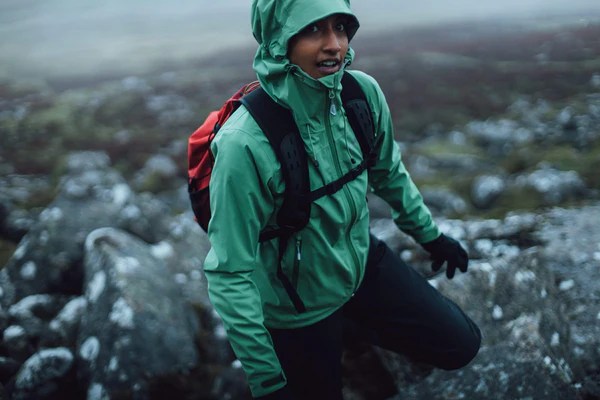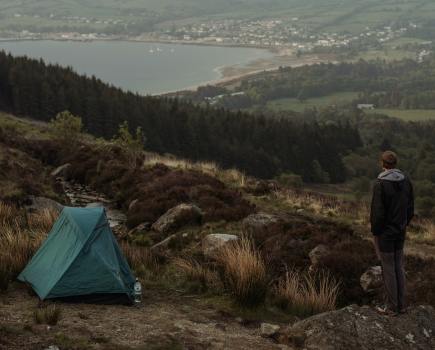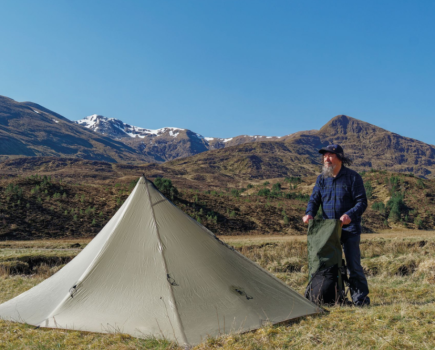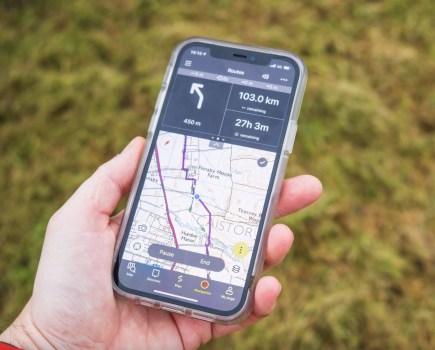A good waterproof jacket or hardshell jacket is an essential for every outdoor adventure and, in a lot of cases, it’s extremely important to have one in your backpack for safety reasons – even if good weather is forecast. Wondering which jacket is best for you? The first thing to think about is the main seasons and types of trips you’ll be needing it for.
For any trips outside of winter, a three-season waterproof jacket will offer you the most versatility. This will protect the you from rain in the months of spring, summer and autumn when temperatures should be warmer and the weather kinder compared to winter. The best three-season hardshell jacket will be able to cope with downpours and strong winds and will come with numerous useful features. After all, walkers can experience fairly extreme weather in any month, especially if high in the mountains.
Just like with hiking boots, when the winter months come around some three-season hardshell jackets will be able to cope with the milder days at that time of year, but if you’re planning on heading out into snow and up to exposed places then something hardier, warmer and more specced-out is needed. In other words, that’s when you’ll need to be considering a four-season waterproof jacket. Most of the hardshell’s reviewed on this page are three-season but there are some, like the options from Mountain Equipment and Helly Hansen, that will be of use when winter rolls around too. Jump down to the bottom of this page if you’re looking for more information on what to look for when buying a waterproof jackets – we’ve got loads of expert advice for you there.
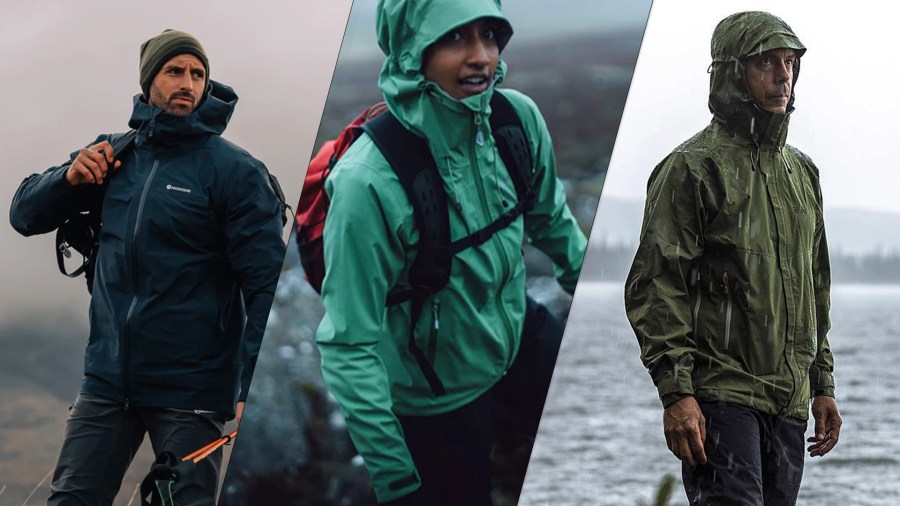
The best waterproof jackets of 2024
This guide contains of the best hardshell jackets for 2024 according to our expert reviewers. Most of these are three-season hardshells but there are also options that will suit tough winter trips in snow too. The jackets have been chosen on the basis of their protection, breathability and durability, with weight, packability, features, fit sustainability and value influencing our decisions too.
Montane Phase Nano
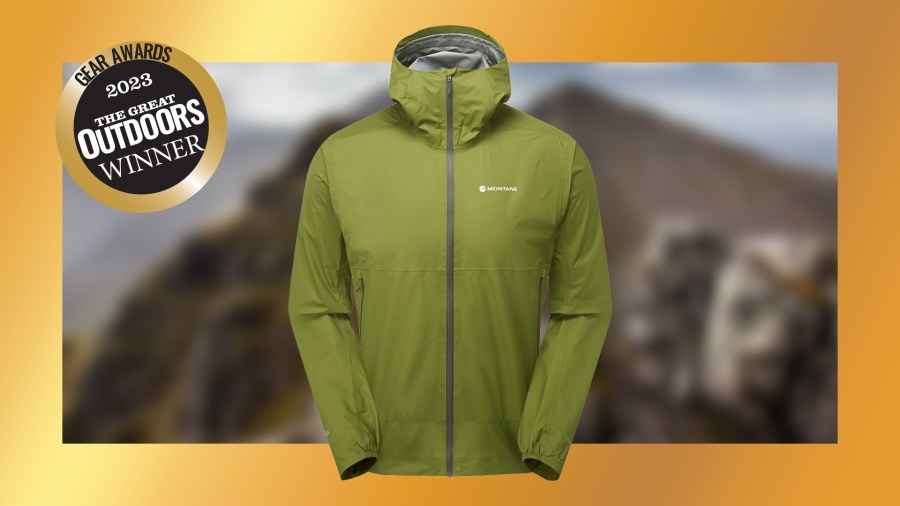
Winner in TGO Awards 2023
“It packs to nothing for just-in-case days, the Gore-Tex fabric is excellent, it has good-sized pockets and it gives perfect articulation with no hem movement at all.”- Low weight
- Breathability
- Packability
- Expensive
- No cuff adjustment
| Quick specs | |
|---|---|
| Price | $379 / £300 (Montane & Go Outdoors) |
| Weight | 250g |
| Materials | 13D Gore-Tex Active, YKK Aquaguard zips |
| Pockets | two hand pockets |
| Hood | 3-point adjustable with stiffened peak |
| Sizes | men S-XXL (no direct women’s version; nearest equivalent is the Phase or Phase XT) |
Montane describes the Phase Nano as the lightest and most breathable Gore-Tex waterproof jacket it offers. Weighing just 250g, it’s a jacket that offers three-layer waterproof protection alongside a bunch of useful design details, including a full length water resistant front zip, a three-point adjustable hood and shaped cuffs.
“It’s a great bit of kit,” said Peter Macfarlane who was on the jury that selected this as the best rain jacket in this year’s Great Outdoors Awards. “It packs to nothing for just-in-case days, the Gore-Tex fabric is excellent, it has good-sized pockets and it gives perfect articulation with no hem movement at all.”
It features Gore-Tex Active, a lightweight version of Gore’s three-layer waterproof fabric that’s designed for high levels of breathability. It’s specifically made for trail running but its three-way adjustable hood, big hand warmer pockets and storm flap make it a good option for summer hikes too – though the 13D fabric might be a little thin to wear with a heavily loaded pack. The phase Nano is now available for both men and women.
Available at: montane.com
Patagonia Granite Crest
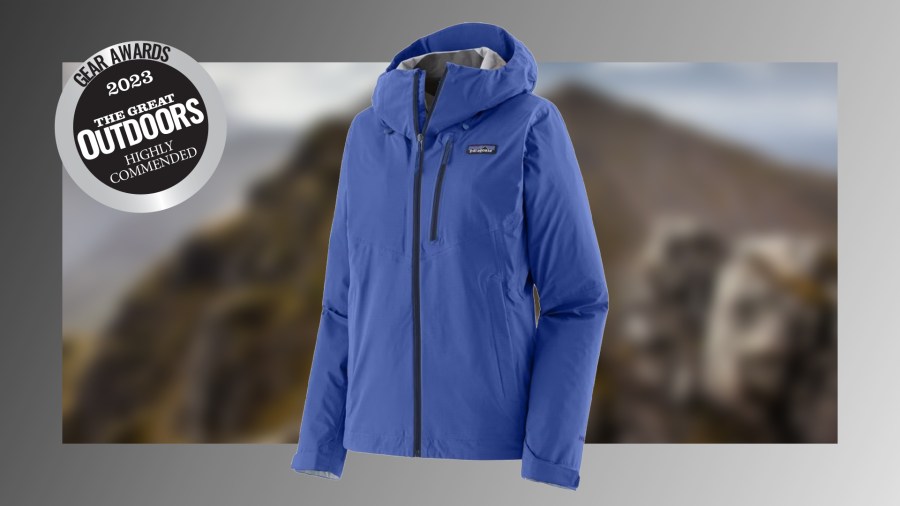
Highly Commended – TGO Awards 2023
From our tests, we found it to be a great three-season option that would be excellent for day hiking and backpacking.- Lightweight
- Hood adjustment
- Recycled Fabrics
- Underarm zips
- Cost
- Hood peak not stiff
| Quick specs | |
|---|---|
| Price | £260 (cotswoldoutdoor.com) |
| Weight | 395g (M) |
| Materials | 3-layer H2No Performance Standard NetPlus post-consumer recycled nylon ripstop with PFC-free DWR |
| Hood | helmet-compatible, front and rear adjustment, stiffened peak |
| Front Closure | zip with internal storm flap, bottom popper |
| Underarm/side zips | Two way |
| Pockets | 2 handwarmer, 1 chest |
| Hem | Adjustable drawcord |
| Cuffs | Velcro |
| Sizes | men XS-XXL (women XS-XL) |
“You’ve got everything you’d want from a good, reliable wet weather shell,” said Will Renwick who was on the jury that chose this as Highly Commended in The Great Outdoors Awards 2023. He tested the Patagonia Granite Crest over the course of a wet backpacking trip in the Lake District.
Not only is the Granite Crest PFC-free but it also uses a fabric that’s made from recycled fishing nets in order to help to reduce ocean plastic pollution. This fabric has a good quality feel to it too; it’s soft to the touch and quiet and there’s a slight stretch to it.
From our tests, we found it to be a great three-season option that would be excellent for day hiking and backpacking. It has a huge helmet-compatible hood that can be adjusted to give good protection whilst allowing visibility, the front drawcords are external ones and so are easily tightened with the jacket fully zipped up and it has a stiffened peak too – though this lacks structure and can distort in the wind.
Other features include large hand pockets, a fully sized chest pocket that can accommodate a map, and long underarm zips for ventilation.
Read our full Patagonia Granite Crest review.
Available at: cotswoldoutdoor.com
RAB Latok
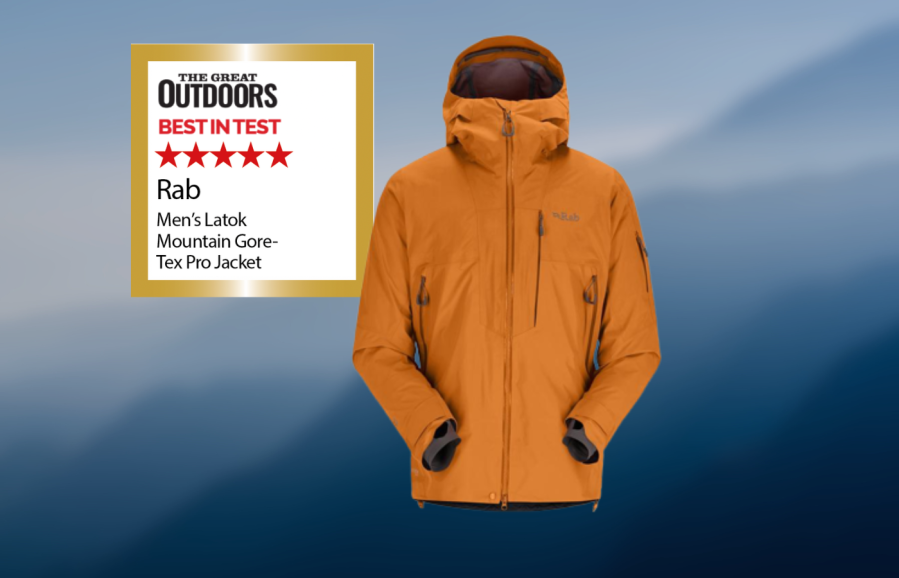
Peter MacFarlane’s best in test 2023
The RAB Latok is a lightweight, relaxed jacket that offers excellent coverage and protection for winter layers.- Fit
- Fabric
- Pockets
- hood
- Comfort
- Main zip can let in water
| Quick specs | |
|---|---|
| Price | $500 / £420 (GoOutdoors) |
| Weight | 510g |
| Materials | 80D and 40D Gore-Tex Pro |
| Hood | wired and stiffened peak, crown and face volume adjusters, roll down |
| Front Closure | zip with internal storm flap, bottom popper |
| Underarm/side zips | 2-way pit zips |
| Pockets | 3 external, 1 internal |
| Hem | Drawcord adjustable |
| Cuffs | Velcro tab |
| Sizes | S-XXL |
| Women’s verison | Yes |
The RAB Latok is a lightweight, relaxed hardshell jacket that offers excellent coverage and protection for winter layers. Its cuffs are wide, allowing for insulated gloves and arm movement. The jacket features three external pockets with water-resistant zips and an internal zipped mesh pocket for a large smartphone. The pit zips are excellent, with a rear storm flap for waterproofing. The heavier Gore-Tex Pro fabrics, DWR and DWR, are excellent and breathable. The brand now has a ‘Material Facts’ table, explaining the amount of recycled materials and fluorocarbon use in the Latok and other equipment.
Read Peter’s full review on the Rab Latok Mountain Gore-Tex Pro Jacket – Tested in 2023
Outdoor Research Helium AscentShell
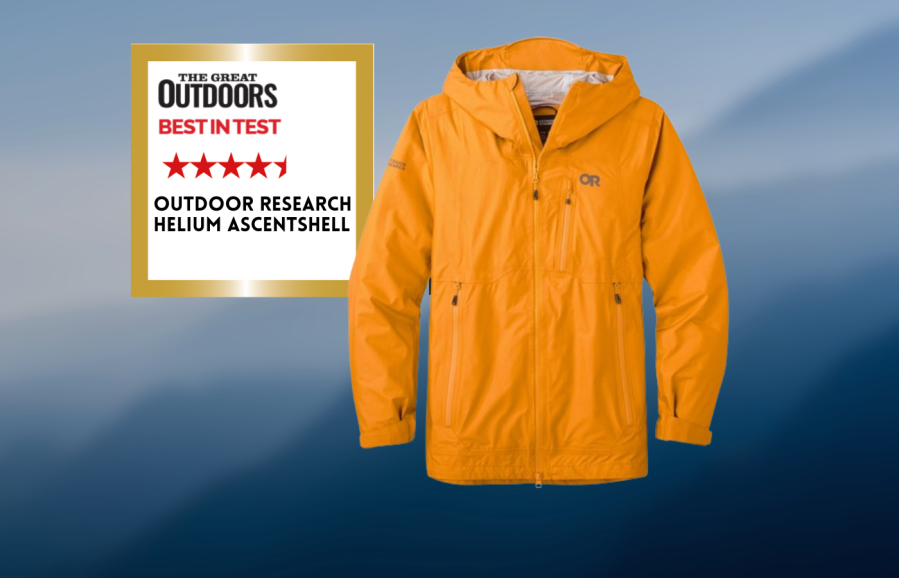
Chris Townsend’s Best in test 2023
Chosen as the one of the best men’s jacket in our tests, the Outdoor Research Helium AscentShell was found to be lightweight, comfortable and tough.- Low weight
- Breathability
- Expensive
- front hood adjustment
| Quick specs | |
|---|---|
| Price | $449 | £425 (outdoorresearch.com ) |
| Weight | 330g (L) |
| Materials | Bluesign-approved AscentShell and Pertex Shield Air Diamond Fuse 30D ripstop nylon |
| Hood | Helmet-compatible, front and rear adjustment, stiffened and wired peak |
| Sizes | men S-XXL (no direct women’s version; nearest equivalent is Women’s MicroGravity AscentShell Jacket, £265) |
Chosen as the one of the best men’s jacket in this guide, the Outdoor Research Helium AscentShell was found to be lightweight, comfortable and tough.
One of the main aspects that impressed us was the AscentShell fabric and the integration of Pertex Diamond Fuse fibres. This creates a lightweight material that is highly abrasion-resistant. Outdoor Research use a method called electro spinning here; this is essentially where thousands of tiny fibres are all joined up together into a web, with gaps that are big enough to expel moisture vapour but small enough to block out moisture in liquid form. It’s impressive stuff.
Adjusting the hood isn’t that smooth, but when done correctly, it does at least offer excellent protection. Pockets-wise, there are inner and outer ones on the chest that will just about hold a medium-size smartphone and there are handwarmer pockets too – these are cut off by a hipbelt but most of them are still usable.
Expect a roomy fit. Our tester Chris found the size Large to be comfortable over fairly thick insulated tops.
Read our full Outdoor Research Helium Ascentshell review. – Tested in 2023
Available at: outdoorresearch.com
Rab Namche
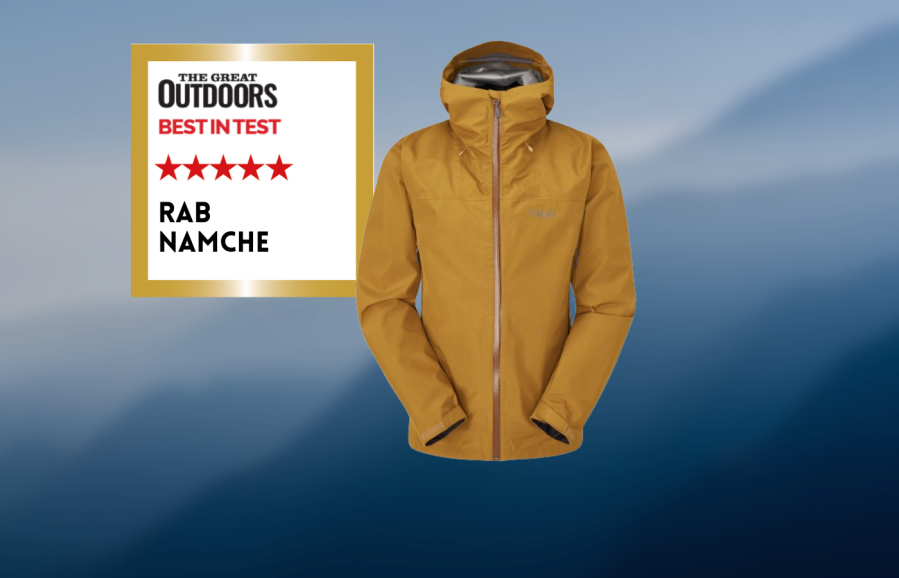
Chris Townsend’s Best in test 2024
The Namche is one of the best jackets I tested for year-round use as it’s substantial enough for severe winter weather but not too heavy or bulky for summer.- Pockets
- Hood
- recycled fabric, PFC-free membrane & DWR
- None
| Quick specs | |
|---|---|
| Price | $350 | £290 |
| Weight | 450g (size UK L |
| Materials | Gore-Tex 3-layer 75D recycled polyester with ePe membrane |
| Hood | Wired and stiffened peak, rear and side adjusters |
| Sizes | S-XXL |
| Women’s version | Yes |
The RAB Namche is a lightweight, durable hardshell waterproof jacket suitable for year-round use, suitable for severe winter weather but not too heavy for summer. It features a PFC-free Gore-Tex ePe membrane, providing a slightly softer feel than similar jackets with old ePTFE membranes. The jacket’s face and backing fabric are 100% recycled polyester, with 50% recycled content. The minimalist design is functional, with a helmet-compatible hood for easy adjustment and a wired peak for side visibility. The jacket has only two large pockets, but they are comfortable and angled for hands. Underarm zips for ventilation are easy to use, and the cuffs are wide enough for ventilation and can be cinched tight. The RAB Namche is a superb jacket, except for a helmet-compatible hood or multiple pockets.
Read Chris’ full Rab Namche Waterproof Jacket Review – Tested across Winter 2023/2024
Montane Phase XT
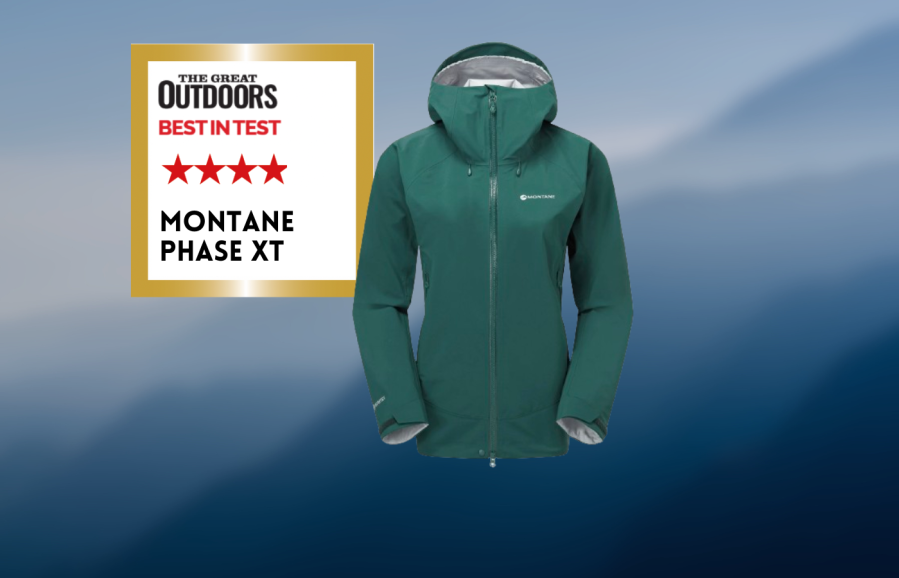
Lucy Wallace’s Best in test 2024
In all aspects the Phase XT is everything I would want in a jacket for winter use, with special mention for the hood, which is near perfect.- Map Sized pockets
- Excellent hood
- slim cuffs are hard to layer over winter gloves.
| Quick specs | |
|---|---|
| Price | $520 / £400 |
| Weight | 458g (size uk 12) |
| Materials | 70D Gore-Tex, 100% nylon face and backer with with ePTFE membrane |
| Hood | Wired and laminated peak, rear and side adjusters |
| Sizes | UK 8-16 |
| Men’s version | Yes |
The Phase XT is a reliable winter jacket with a standard Gore-Tex membrane and 70D face fabric and backer. It features a hood that can easily swallow a climbing helmet and offers good face protection. The hardshell jacket has big hand pockets, an internal valuables pocket, and underarm zips for venting. The cuffs are floppy to fit over insulated gloves with padded wrists, which could result in wet gloves and wrists in foul weather. Overall, the Phase XT is perfect for winter use, with the hood being near perfect.
Read Lucy Wallace’s full Montane, Women’s Phase XT review – Tested across Winter 2023/2024
Sprayway Torridon
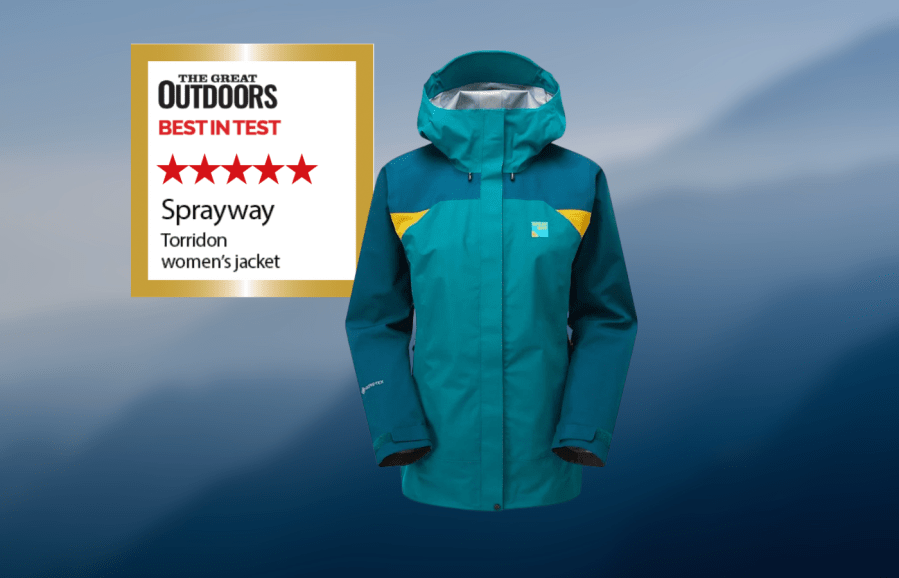
Fiona Russell’s Best in test 2023
The somewhat retro style also brings a strangely comforting sense of nostalgia. The price is good for such a high-spec jacket.- Fabric
- Eco
- Colours
- Hood
- Weight
- Height of pockets
| Quick specs | |
|---|---|
| Price | £340 / International shipping available |
| Weight | 568g |
| Materials | 3-layer Gore-Tex 75D PFCEC-free recycled polyester |
| Hood | wired, 2 adjusters |
| Sizes | UK 6-20 |
| Men’s version | Yes |
The Sprayway Torridon is a waterproof jacket designed to provide freedom of movement and layering. It features a longer length at the rear and arms, a hood with good volume, and a Velcro tab for easy adjustment. The jacket offers a robust outer shell, two-way pit zips, double stormguard, and stud and Velcro fastening. The zipped hand pockets are large and useful, and it adheres to eco and ethical standards. The three-color panelling design provides visibility and a retro style, making it a good value rain jacket for its high-spec price.
Read Fiona’s full Sprayway Torridon women’s jacket review – Tested in 2023
Arc’teryx Beta
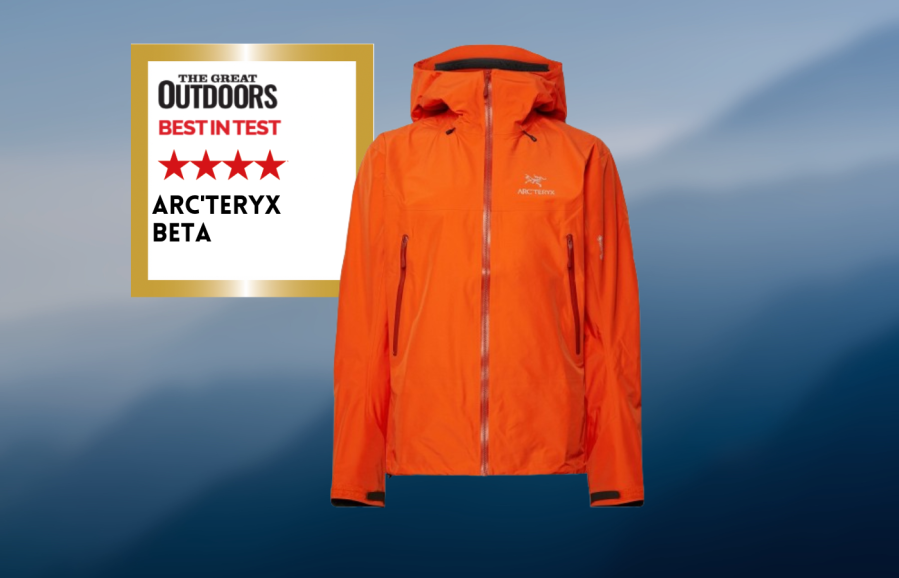
Fiona Russell’s Best in test 2023
At £350, the Arc’teryx Beta is one of the more expensive options out there, but it is at least very high in quality.- Lightweight
- Roomy
- Price
- Colours
| Quick specs | |
|---|---|
| Price | $450 | £350 (ellis-brigham.com) |
| Weight | 269g (S) |
| Materials | 3-layer Gore-Tex with Gore C-Knit backer |
| Hood | stiffened peak, single volume adjuste |
| Sizes | XXS-XXL (men XS-XXL) |
| Men’s version | Yes |
At £350, the Arc’teryx Beta is one of the more expensive options out there, but it is at least very high in quality.
It uses a three-layer Gore-tex fabric, including a light shell layer, the membrane underneath and then a C-knit backer which helps to wick moisture and to protect the membrane from abrasion and body oils (which can block up the membrane’s pores).
The fabric has a durable feel to it, but the rain jacket is still lightweight and packable, so Arc’teryx have struck a really good balance here.
Features include a soft fabric chin guard, an adjustable helmet-friendly hood, Velcro cuffs and glove-friendly zip pulls. There are three zipped pockets, including two hand pockets at the right height for wearing with a rucksack, as well as an internal zipped laminated pocket that is big enough to accommodate a large smartphone.
Read Fiona’s full Arc’teryx Beta jacket review. – Tested in 2023
Available at: ellis-brigham.com
Mountain Equipment Makalu
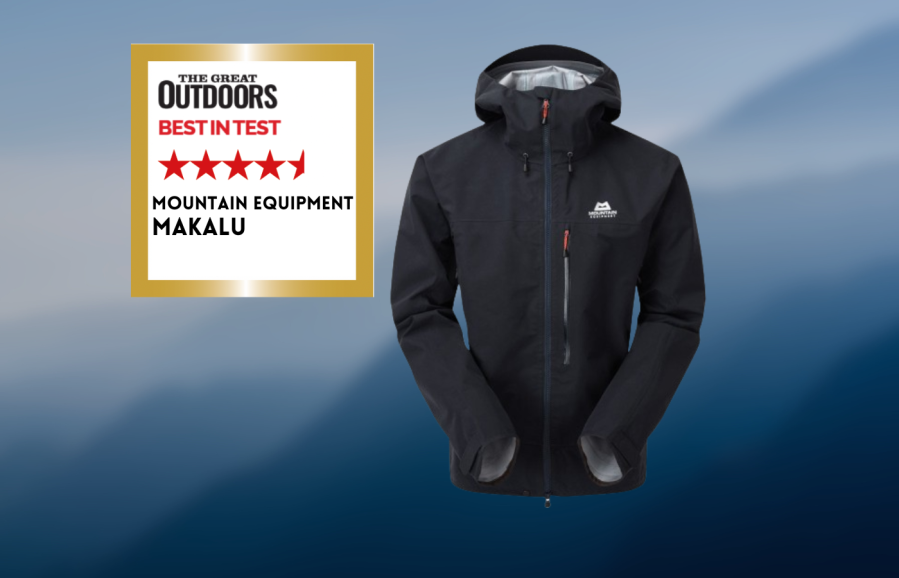
Lucy Wallace’s Best in test 2023
Sure, £270 is still a sizeable wedge for quite a simple garment; but you do get a waterproof with tried and tested features plus strong build quality that means it should last several seasons.- Excellent Hood
- Tough
- No Frills
| Quick specs | |
|---|---|
| Price | $374.95 | £270 |
| Weight | 516g (Size 12) |
| Materials | 3-layer 75D/recycled 50D Gore-Tex, PFC-free DWR |
| Sizes | 8-16 |
| Men’s version | Yes |
The Makalu from Mountain Equipment went down well in our tests, mainly due to its tried-and-tested features and strong build quality. It’s not the most expensive jacket in the test – although at £270 it’s still quite a sizeable amount of money to part with. But for that you get a well-designed, robust and versatile waterproof that should last several seasons.
Its main body is 100% recycled 50 denier, with tougher 75 denier on the wear points. The entire shell has been treated with a PFC-free (less environmentally damaging) DWR to repel water.
A standard Gore-Tex waterproof membrane is employed here. It’s not the top spec Gore-Tex Pro but the quality is still impressive.
Our tester’s favourite aspect of this rain jacket is the hood. They found it roomy and adjustable and they liked that it has a stiffened brim and a wire peak.
See our full review of the Mountain Equipment Women’s Makalu Jacket review. – Tested in 2023
Available at: cotswoldoutdoor.com
Helly Hansen Odin 9 Worlds 3.0
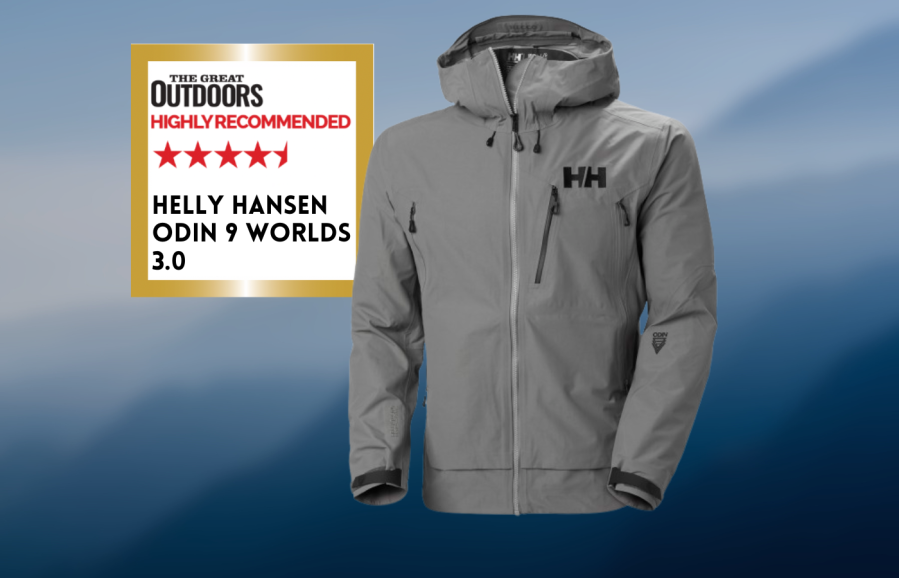
Highly Recommended
For winter mountains this is a great jacket. It is quite heavy though and overkill for summer.- Hood
- Pockets
- Recycled Content
- Weight
- Price
| Quick specs | |
|---|---|
| Price | $475 / £440 (TrekInn) |
| Weight | 610g (size UK XL) |
| Materials | Helly Tech Professional 3-layer 68% recycled polyamide/32% polyamide |
| Hood | wired and laminated peak, rear and side adjusters, helmet compatible |
| Sizes | S-2XL |
| Women’s version | Yes |
Helly Hansen provided an XL size Odin 9 Worlds 3.0 waterproof jacket, allowing it to be worn over an insulated jacket without feeling tight. This jacket is designed for burly winter weather and is lightweight and stiff. The front pockets are double-layer, providing excellent breathability. The hood is helmet-compatible and can be closed around a hat or bare head. The jacket has large pockets that can hold a large amount of gear, with double zip pullers for easy access. A smaller chest pocket is ideal for a compass or smartphone. The underarm zips have double zip pullers, but they are stiff and awkward to use. Wide cuffs fit over gloves and allow ventilation. While this jacket is great for winter mountains, it is heavy and overkill for summer.
Read Chris Townsend’s full Helly Hansen Odin 9 Worlds 3.0 Review – Tested across Winter 2023/2024
Helly Hansen Odin 1 World Infinity Shell
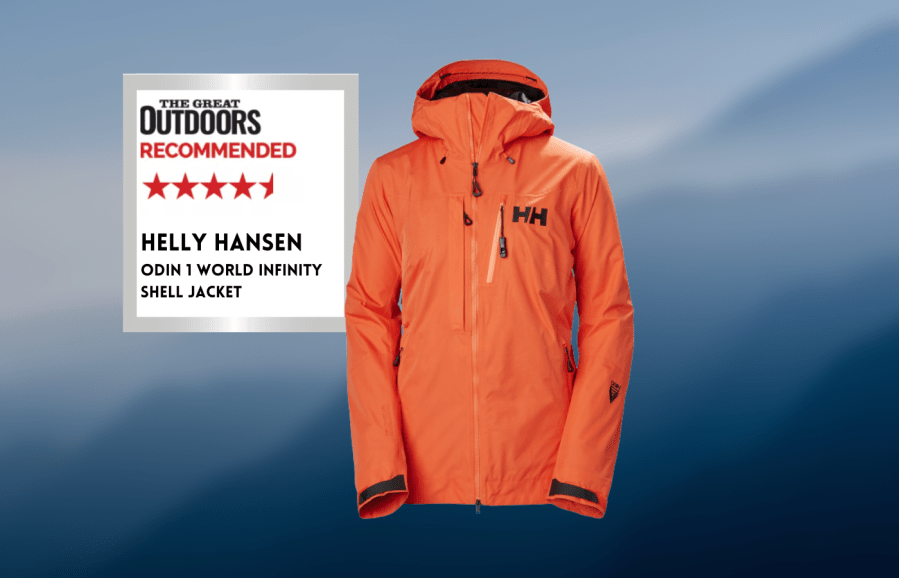
TGO Recommends
Given how protective its waterproof fabric, this is a good jacket to turn to when stormy weather is forecast. It’s also got some excellent eco credentials- Lightweight
- Environmentally friendly
- Expensive
| Quick specs | |
|---|---|
| Price | $500 | £420 |
| Weight | 1 lb. | 455g (L) |
| Materials | PFC-free recycled polyamide/ polypropylene membrane |
| Hood | front drawcord, rear volume adjuster, stiff peak, helmet compatible |
| Features | side ventilation zips, Recco transponder, emergency whistle in chest pocket |
| Sizes | men S-XXL, women XS-XXL |
| Women’s version | Yes |
Given how protective its waterproof fabric, this is a good jacket to turn to when stormy weather is forecast. It’s also got some excellent eco credentials as its 100% PFC free and made using recycled materials.
The jacket has a protective hood and big pockets, the comfort is good as the fabric isn’t as stiff or noisy as some heavy-duty ones and the breathability is also good, with the inside only getting a little damp with condensation during our tests. The zipped side vents helped here as did the wide cuffs, which allow ventilation to the sleeves.
Worn over just a light mid layer and a base layer the fit is quite loose, which creates freedom of movement and also allows for a thicker layer of insulation underneath in the colder months.
Read Chris Townsend’s full Helly Hansen Odin 1 World Infinity review – Tested in 2023
Available at: hellyhansen.com
Patagonia Triolet
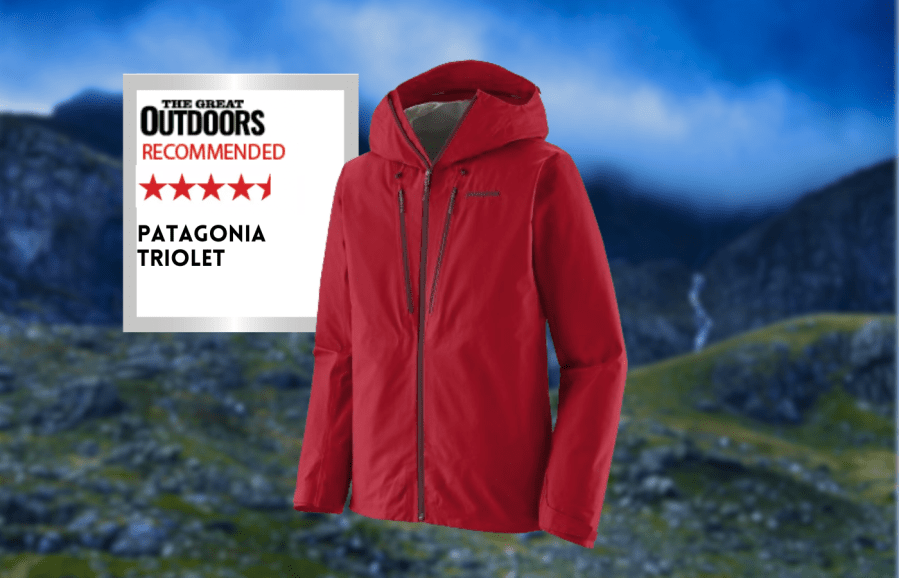
TGO Recommends
For mountaineering where a climbing helmet is worn the Triolet is an excellent jacket. It works fine for hillwalking too, if you can manage with the over-sized hood.- Pockets
- recycled fabric, PFC-free membrane & DWR
- Huge hood is hard to adjust
- Cost
| Quick specs | |
|---|---|
| Price | $449 | £390 |
| Weight | 550g (size UK L) |
| Materials | Gore-Tex 3-layer 75D recycled polyester with ePe membrane. |
| Hood | Wired and laminated peak, rear and side adjusters, helmet compatible |
| Sizes | XS-XXL |
| Women’s version | Yes |
The Triolet is a waterproof jacket designed for alpine workhorses, featuring a helmet-compatible hood and a RECCO reflector for searchability by rescuers. The fabric is soft and flexible, similar to Rab Namche, and offers comparable breathability to the Gore-Tex ePTFE membrane. The hood is large and can be cinched down around a hat or bare head, providing excellent protection. The two large chest pockets hold maps but are not suitable for handwarmers. The underarm zips run freely and have double zip pullers, allowing for easy opening or closing. The cuffs are wide enough for ventilation and fit over gloves. The Triolet is an excellent choice for mountaineering and hillwalking, especially if a climbing helmet is worn. The jacket is suitable for both mountaineering and hillwalking, provided the over-sized hood is worn.
Read Chris Townsend’s full Patagonia Triolet Waterproof Jacket Review – Tested across Winter 2023/2024
Tierra Back Up
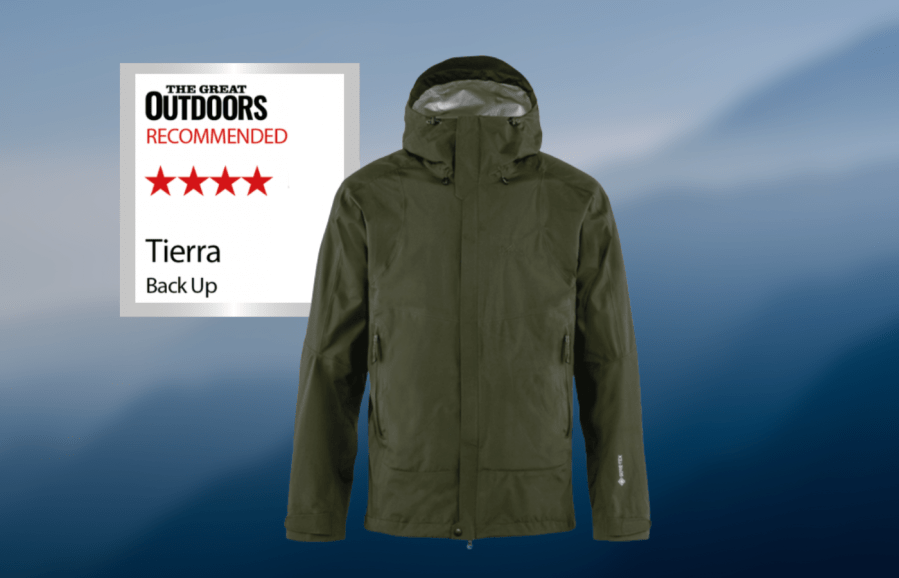
TGO Recommends
The Back Up is well-priced and a good choice if you’re not looking for a jacket for winter storms.- Lightweight
- Hood Adjustment
- Cost
- Mosquito net
- No chest pockets
- Hood peak not very stiff
| Quick specs | |
|---|---|
| Price | £260 |
| Weight | 355g (L) |
| Materials | 50 denier Gore-Tex Paclite polyester with PFC-free DWR |
| Hood | front and rear adjustment, stiffened peak |
| Sizes | Men S-XXL (women XS-XL). |
| Women’s version | Yes |
Tierra are a Swedish company that specialise in wet weather gear – no less than the Swedish Alpine Mountain Rescue association are equipped with their kit.
This particular jacket, the Back Up, uses Gore-Tex Paclite. This has a hydrostatic head of 28,000mm, high levels of breathability and it’s also lightweight and packable – all the right ingredients of a backpacking jacket then.
The Tierra Back Up hood fits well and has external front drawcords and cordlocks, making it easy to adjust. The hood isn’t helmet-compatible, so there isn’t masses of material to cinch down when you’re not wearing one. The peak is small and it’s not very stiff.
The pockets are roomy. Unfortunately they’re cut off when wearing a backpack with a hipbelt but the top of them can still be used. There are no chest or inner pockets.
One extra feature that will be useful in the summer months is a stuff sack that doubles as a midge net!
Read Chris Townsend’s full Tierra Back Up review. – Tested in 2023
Available at: tierra.com
Paramo Velez Adventure Smock
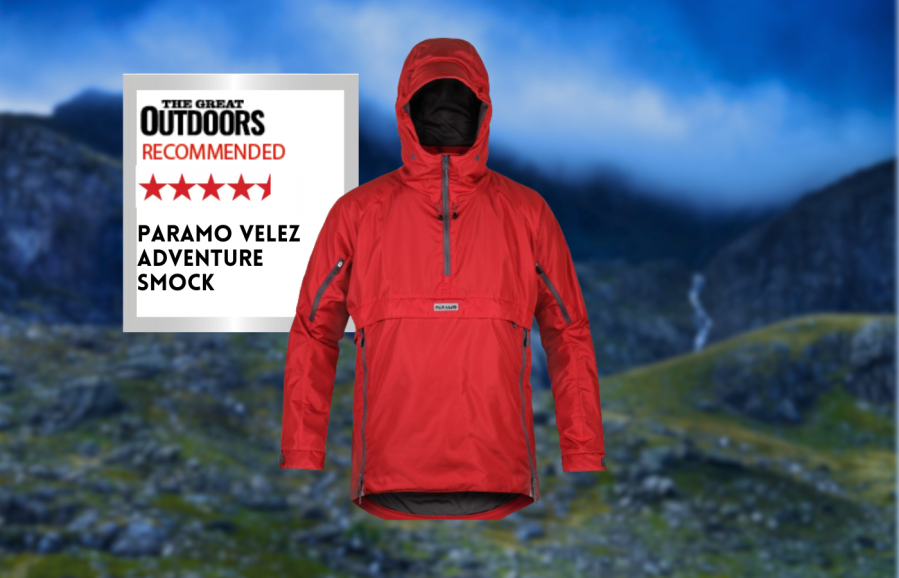
TGO Recommends
The Velez Adventure Smock is warmer than a conventional waterproof jacket, so you don’t need to wear as much under it. I find it excellent in cold winter weather.- Comfort
- Breathability
- Hood
- Pockets
- Heavy
- Too warm for summer
| Quick specs | |
|---|---|
| Price | £280 |
| Weight | 810g (Uk size L) |
| Materials | Nikwax Analogy Waterproof polyester fabric |
| Hood | wired and laminated peak rear and side adjusters |
| Sizes | S-XXL |
| Women’s Version | Yes |
Paramo waterproof jackets have two layers of material, one for wind deflection and the other for moisture removal. They are effective when kept clean and treated with Nikwax TX.Direct. They are breathable and comfortable, but not light and best worn all day. The Velez Adventure Smock is designed for high-energy activities in cold and wet conditions, offering excellent ventilation with two long two-way front zips and zipped upper arm vents. The hood has a wired peak for protection without hindering vision. The smock has a large kangaroo pocket for maps and other items, a small zipped pocket inside for compass and phone, and another zipped pocket across the front. The main front zips can be partially unzipped to warm hands. The Velez Adventure Smock is warmer than conventional waterproof jackets, making it ideal for cold winter weather.
Read Chris Townsend’s full Paramo Velez Adventure Smock Review, – Tested across Winter 2023/2024
Fjallraven, Bergtagen Eco-Shell W
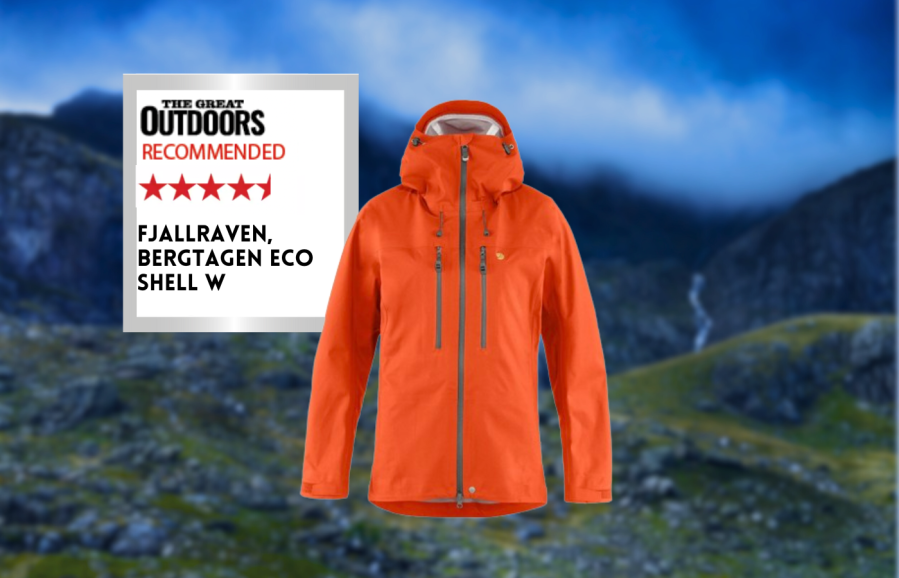
TGO Recommends
It’s the most expensive jacket in my selection, and the weightiest. If this doesn’t put you off, it’s definitely worth a look as a comfortable and practical mountain shell for winter,- good eco credentials
- Harness compatable pockets
- Expensive
- Check sizing
| Quick specs | |
|---|---|
| Price | £575 / €599,95 / $550.00 |
| Weight | 522g (size medium) |
| Materials | Eco-shell stretch ripstop (70% recycled polyester) with proprietary membrane |
| Hood | laminated wired hood with rear and side adjusters |
| Sizes | XXS-XL |
| Men’s version | Yes |
The Bergtagen Eco-Shell W is a waterproof jacket that uses Fjallraven’s proprietary membrane instead of Gore-Tex. It stayed dry and comfortable during a three-day expedition in the mountains in December. The jacket is made from 70% recycled polyamide and protected by a PFC-free DWR finish. It features large pockets, venting zips, generous cuffs, and a Recco Reflector. The hood is large and may be too big for some, possibly due to its size. The Bergtagen Eco-Shell W is the most expensive and weightiest jacket in the selection, but it is a comfortable and practical mountain shell for winter with a smaller ecological footprint. It is worth a look if you’re looking for a comfortable and practical winter shell.
Read Lucy Wallace’s full Fjallraven, Bergtagen Eco-Shell W Review – Tested across Winter 2023/2024
Jöttnar Odin
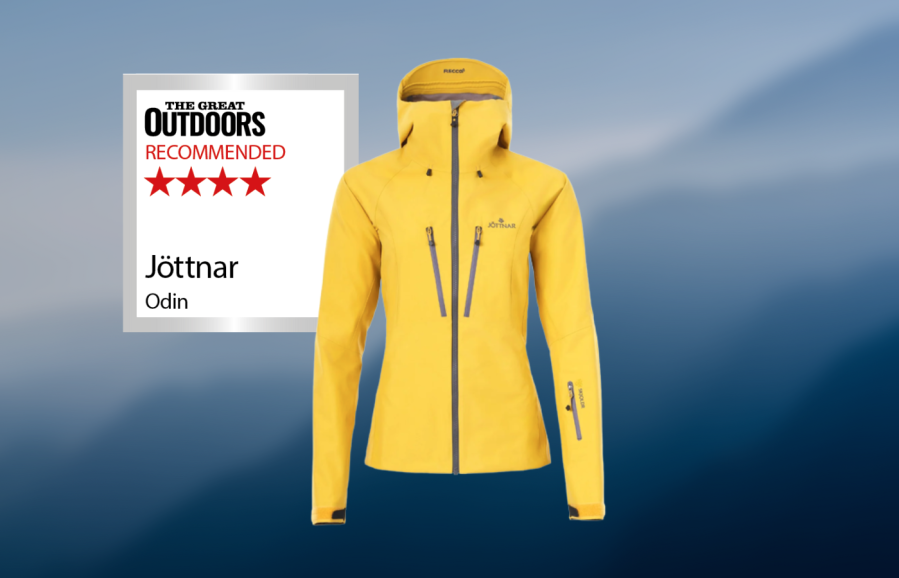
TGO Recommends
The Odin is a durable, high-quality waterproof jacket suitable for winter layers However, the rain jacket loses a point in the scoring due to its lack of environmental or ethical considerations- Fabric
- Fit
- Features
- Price
- Peak
| Quick specs | |
|---|---|
| Price | £495 / $595 |
| Weight | 514g |
| Materials | 3-layer, 80 denier Jöttnar Skjoldr |
| Hood | Wired, 2 volume adjusters |
| Sizes | XS-L |
| Men’s version | Yes |
The Odin is a durable, high-quality waterproof jacket suitable for winter layers, with a softer chinguard and a wide internal storm gasket on the front zip. It is one of the heavier jackets in our guide to the best waterproofs. The hood is too big for hillwalking and the peak is short and wired. The jacket is breathable and has five pockets, two internal pockets, a sleeve pocket, a Recco Rescue System diode, and an antenna-based passive transponder for safety. The bright yellow color is great for mountain safety. However, the rain jacket loses a point in the scoring due to its lack of environmental or ethical considerations and its high price.
Read Fiona’s full Jöttnar Odin Jacket review – Tested in 2023
RAB Arc Eco

TGO Magazine verdict
Perhaps not a rain jacket for the depths of winter but it is a light, simple, cheap and more environmentally-friendly option for backpacking and hillwalking.- Eco credentials
- Great all-rounder
- Cost
- Needs more pockets
| Quick specs | |
|---|---|
| Price | $235 | £200 |
| Weight | 436g |
| Materials | 3-layer Pertex Shield recycled polyester ‘Revolve’, recycled inner, PFC-free DWR |
| Features | Part-wired 3-way adjustable hood, 2 large pockets |
| Sizes | S-XXL |
| Women’s version | Yes |
The Rab Arc Eco was given Gold in our TGO awards for sustainability and it has really stood out from the other men’s waterproofs here too. On test since last autumn, the fully recycled fabric has so far resisted wear and tear, with the 20,000 hydrostatic head and 15,000 MVTR (breathability rating), continuing to keep us completely dry.
Our tester found the cut of the jacket is quite long, and perhaps overly roomy at the chest, but this does at least allow for layering. The sleeves are Velcro-adjusted, and the hem adjusted by two toggles. As for pockets, there are only two very large handwarmers, situated just high enough to be useable whilst wearing a rucksack.
Perhaps not a rain jacket for the depths of winter but it is a light, simple, cheap and more environmentally-friendly option for backpacking and hillwalking.
Read our David Lintern’s full Rab Arc Eco review. – Tested in 2023
Berghaus Paclite Dynak Gore-Tex
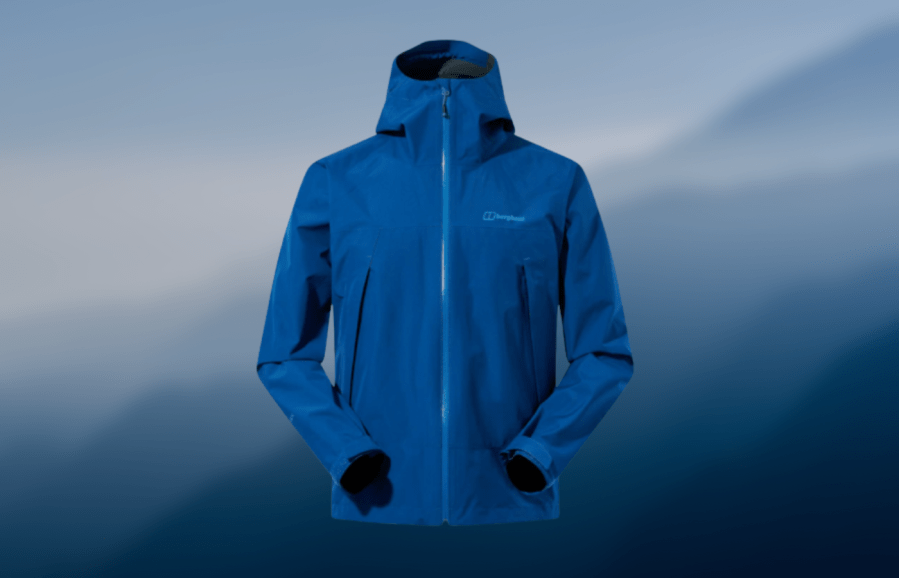
TGO Magazine verdict
The overall fit of this rain jacket is fairly relaxed, especially compared to trimmer fitting shells, with room for a layer or two underneath.- Packable
- Climate friendly
- Hood minimalist
| Quick specs | |
|---|---|
| Price | £170 |
| Weight | 292g (10) |
| Materials | 2-layer Gore-Tex Paclite, taped seams |
| Hood | stiffened, one adjuster |
| Sizes | women UK8-18 (men XS-XXL) |
| Men’s version | Yes |
£170 is excellent value for a rain jacket of this calibre. It’s light, it’s durable, it’s breathable and protective and it’s well furnished with features – there’s a lot to like here.
It’s not quite as nice to wear as a 3-layer shell if you’re forced to keep it on for extended periods but the inner face does at least have a built-in carbon backer instead of a clingy drop liner or printed ‘half-layer’ like many cheaper 2.5-layer PU-based shells and that means it provides reasonable comfort levels. We found that it only started to feel a bit clammy when really working hard uphill.
The one-way, water-resistant main zip has an internal storm flap and a comfortable microfibre chin guard. The two hand pockets are a decent size and are placed high enough to stay out of the way of a backpack hip belt. The pocket zips aren’t watertight but they do have double storm flaps – so there’s peace of mind there.
The overall fit of this hardshell jacket is fairly relaxed, especially compared to trimmer fitting shells, with room for a layer or two underneath.
Read our full Berghaus Paclite Dynak Gore-Tex review. – Tested in 2023
Available at: berghaus.com
Haglofs Roc Flash GTX
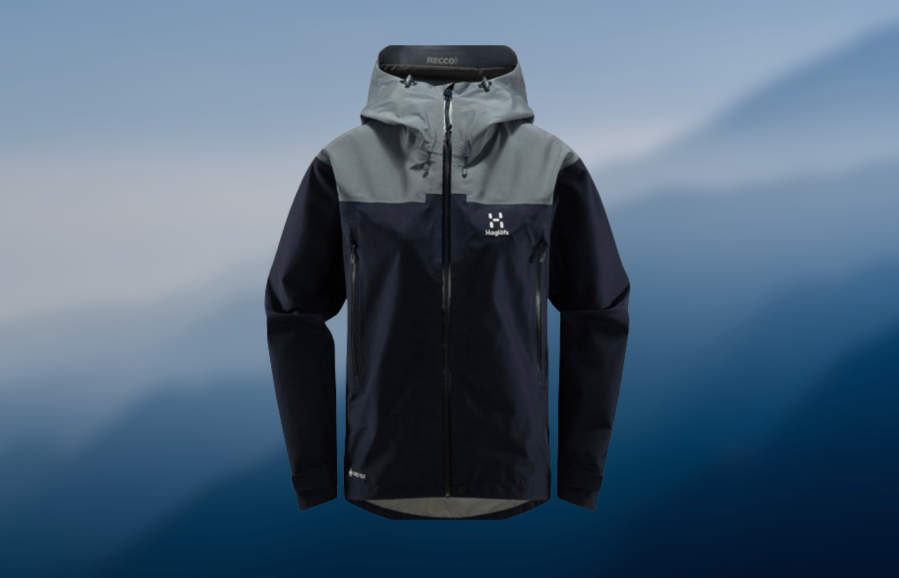
TGO Magazine verdict
it’s a jacket that inspires confidence, built from 100% recycled 75 denier polyamide, with a Gore-Tex membrane, it’s reassuringly tough and waterproof. The eco-credentials are better than most.- Generous Pockets
- Good Eco credentials
- Hood
| Quick specs | |
|---|---|
| Price | $336 / £380 |
| Weight | 471g (size medium) |
| Materials | Gore-tex 3L, 75D, 100% recycled polyamide with ePTFE membrane |
| Hood | laminated peak, rear and side adjusters |
| Sizes | XS-XL |
| Men’s version | Yes |
The Roc Flash GTX hardshell jacket is a practical and stylish choice for outdoor enthusiasts. It features roomy external hand pockets, an internal valuables pocket, and a cuff that slides over insulated gloves. The jacket also has underarm zips for venting and a Recco reflector for quick rescue in winter. However, the hood is tight and the laminate panel in the peak doesn’t hold its shape in strong wind. Despite these issues, the jacket is built from 100% recycled 75 denier polyamide and has a Gore-Tex membrane, making it tough and waterproof. Haglofs has achieved these eco-credentials at a competitive price point.
Read Lucy Wallace’s full Haglofs Roc Flash GTX Women Review – Tested across Winter 2023/2024
How we tested
Chris Townsend, equipment editor
Our equipment editor Chris Townsend is known globally as a writer on hiking and backpacking skills and equipment, the author of 25 books – many of them award-winning – and as a record-setting long-distance hiker. He was the first person to complete a continuous round of all the Scottish Munros and Tops and the first person to complete a continuous walk the length of the Canadian Rockies. He has also walked the Scottish Watershed and walked coast-to-coast across Scotland 18 times. In the USA he has walked the Pacific Crest Trail, Continental Divide Trail, Pacific Northwest Trail and Arizona Trail plus several self-devised long walks. Other walks include south-to-north through the mountains of Norway and Sweden and 1000 miles through the Yukon Territory. He has also worked as a Nordic ski tour leader in Scandinavia and other places and as a trek leader in the Himalayas.
Lucy Wallace
Lucy is a Mountain Leader (Summer, Winter and International), and wildlife guide who has worked professionally in the outdoors since 2007. She is based on Arran and works throughout Britain, Europe and Tanzania, on everything from environmental conservation, the Duke of Edinburgh Award scheme to Mountain Leader training and assessments. She has tested and reviewed outdoor gear for various titles since 2012 and joined the review team in 2019.
Fiona Russell
Fiona is better known as Fiona Outdoors, a journalist and award-winning outdoors writer. She lives in the Scottish Highlands and enjoys hillwalking, trail and hill running, back country skiing, sea kayaking, off-road cycling and wild swimming. She was introduced to hillwalking while at the University of Newcastle in the early 1990s. Fiona has compleated the Munros and is now working through her Corbetts.
Peter Macfarlane
Peter combines a life in the outdoors with an engineering background to consult on gear design and carry out pre-production testing. His outdoors journey started with the scouts in the 70’s and drew him into the Scottish hills, where you’ll find him in every season, often with a tent. Peter tests gear throughout the highlands, as well during his regular work as a Woodland Trust ranger.
David Lintern, deputy editor
David is the deputy editor of The Great Outdoors. He looks after the narrative features and coordinates gear reviews for the magazine. He has been hillwalking since the late 90’s, and an outdoor writer and photographer since 2011. His very first feature was with The Great Outdoors. He has since produced three award winning books and worked as an editor, journalist, TV researcher, location scout and photography tutor. In addition to walking and backpacking, he’s a keen packrafter, cyclist and winter mountaineer, and a learner climber and skier. He has been lost and found in the Indian Himalaya, the Sierra Nevada (both of them!), the Pyrenees, the Alps, Arctic Lapland and all over Britain.
How to choose the best waterproof jackets
Finding the right waterproof jacket can greatly enhance your comfort and performance in adverse weather conditions. It’s also absolutely crucial from a safety perspective. First and foremost, the main things to assess when choosing a rain jacket are the levels of waterproofness and breathability as these determine its ability to keep you dry while allowing moisture to escape. Additionally, consider the hardshell jacket’s durability, weight, and packability to match your intended activities and environment. If you like to move fast and light, for instance, then a lightweight 2.5-layer shell that’s light on features will be best for you. Conversely, if you’re into your winter mountaineering then you’ll want a more durable shell – 3-layer perhaps – with pockets and lots of adjustment.
Pay attention to features like hood design: is there adjustment so that it will hold in high winds? And pocket placement: will they be accessible when you’re wearing a baclpack with a hipbelt? You’ll also want to take into account the jacket’s fit and sizing to ensure optimal comfort and freedom of movement – many of our full individual jacket reviews will specify whether a jacket is true to size or not. If we don’t specify in the review, please feel free to get in touch with us directly to ask.
Finally there’s the sustainability side of things. If you’re conscious of the environmental impact of products, check whether any recycled materials are present and also whether the materials can go on to be recycled when the jacket comes to the end of its life. Some jackets these days still come with PFCs. These are water resistant chemicals that often escape through our washing machines and into the world’s water supplies where they stay for a very long time. Studies have found these in the world’s deepest oceans and even on the summit of Everest!
Fabric
The type of fabric determines how ‘breathable’ a garment will be. More expensive fabrics are usually more breathable than cheaper ones. The thickness of a fabric affects durability. The thinnest ones are lighter in weight but less suitable for prolonged wear or rough usage. The best quality rain jackets will have three-layer waterproof fabrics. This means that the membrane is sandwiches between a protective outer shell fabric and an inner lining that keeps the membrane protected from abrasion and from dirt from your body oils and sweat. 2.5-layer fabrics, where the inner lining is sprayed or printed onto the inside of the jacket, tend to be employed by lightweight waterproof jackets. Then you have 2 layer jackets which are usually low in cost. These have a membrane, an outer fabric and then usually a mix of mesh and non-technical polyester fabric on the inside.
DWR
Most waterproof fabrics have a durable water repellency (DWR) treatment that causes rain to bead up and run off the garment. Whilst no DWR is really durable the best for many years were fluorocarbons (PFCs). However, these have been found to be harmful to health and to persist a very long time in food chains and the environment, so they are being phased out and replaced with more environmentally friendly though usually less durable alternatives. Whatever the DWR it will wear off eventually, so the outer starts to soak up water. This doesn’t mean the jacket is leaking but it does mean breathability will be reduced so condensation will occur more readily. The DWR can be replaced with various wash-in and spray-on treatments.
Hood
On the best waterproof jackets, hoods should be easily adjusted and ideally move with your head. A wired or stiffened peak is useful in wind driven rain. Helmet-compatible hoods should have volume adjusters so they can be reduced in size without affecting your vision for non-helmet wear.
Front Closure
Water-resistant zips are now standard in the best waterproof jackets. These are not fully waterproof all the time and should have an inner flap to repel any rain that gets through. A standard zip with external and internal flaps is more secure but found on few garments these days.
Ventilation
Underarm/side zips can be awkward to use but do allow good ventilation at a crucial place. Often used in rain jackets when the front zip has to be fully closed. Zips that curve under the armpits are effective but the most difficult to adjust. Pockets can be opened for ventilation too if they are mesh lined.
Cuffs
Cuffs that can be opened wide are good for ventilation in the arms. Elasticised and narrow cuffs on rain jackets can lead to sweaty wrists.
Pockets
Whilst not essential, pockets that are accessible when wearing a rucksack hipbelt are useful for items like compass, phone, snacks, map (if large enough), hat and gloves and feature on many of the best waterproof jackets. Pockets can leak though so need water-resistant zips and/or covering flaps.
Fit
For the most efficient breathability, the best waterproof jackets should fit fairly closely. At the same time, they shouldn’t be so tight that they restrict movement. And a rain jacket should fit comfortably over all the layers you might need to wear underneath it. Size labels should be taken as a guide only – they’re not consistent between makes.
Waterpoofing, breathability, adjustment, fit, features, sustainability and of course price. There’s a lot to consider, but by carefully weighing these up you can make a well-informed choice and invest in a waterproof shell that could serve you well and for a long, long time.
How waterproofness and breathability are measured
If you want to know how to stay dry when hiking in the rain, it’s important to consider a rain jacket’s waterproofness and breathability. If the weather is wet and warm, the fabric needs to have the capacity to let the moisture created by sweat to escape, otherwise you will end up damp inside the rain jacket. These days there are excellent waterproof and breathable membranes (which are also windproof). Most jackets also have a durable waterproof repellency (DWR) treatment added to the outer layer of fabric.
The waterproofness of a rain jacket is measured by determining the height of a column of water that the fabric can withstand before it starts to leak through. The resulting figure is known as the hydrostatic head (HH) and this is expressed in millimetres – the higher the number, the more waterproof the jacket is considered to be.
The breathability of waterproof garments is determined by the “Moisture Vapor Transmission Rate” (MVTR). This test measures the amount of water vapor that can pass through the jacket’s fabric over a given period of time. The unit of measurement used is typically grams per square meter per 24 hours (g/m²/24h). The higher the MVTR rating, the more breathable the jacket is considered to be.
Finally, colour choice may seem less important but a brighter shade will allow you to be more easily seen should you get into difficulty. Black, dark blues and greens blend in rather than stand out. Also, very light shades will show the dirt quickly.
Some waterproof fabric examples and their ratings
Hydroshell (Berghaus) – HH: 15,000 mm | MVTR: 20,000 g/m²/24h (official)
Dermizax EV – HH: 25,000 mm | MVTR: 20,000 g/m²/24h (official)
Unbranded (Alpkit Balance) – HH: 20,000 mm | MVTR: 20,000 g/m²/24h (official)
Polartec Power Shield – HH: 20,000 mm | MVTR: 20,000 g/m²/24h (official)
Futurelight (The North Face) – HH: Unknown | MVTR: 75,000 g/m²/24h (official)
Pertex Shield – HH: 20,000 mm | MVTR: 20,000 g/m²/24h (estimated)
H2No (Patagonia) – HH: 10,000mm to 20,000 mm | MVTR: 12,000 – 15,000 g/m²/24h (estimated)
Omni-Tech (Columbia) – HH: 10,000 mm | MVTR: 10,000 g/m²/24h (estimated)
eVent – HH: 30,000 | MVTR: 15,000 to 25,000 g/m²/24h (estimated)
Gore-tex – HH: 28,000 mm | MVTR: 17,000 g/m²/24h (estimated)
Gore-tec Paclite – HH: 28,000 mm | MVTR:15,000 g/m²/24h (estimated)
Gore-tex Pro – HH 28,000 mm | MVTR: 25,000 g/m²/24h (estimated)
How to look after the best waterproof jackets
Looking after waterproof jackets can be trickier than a normal piece of clothing; they require a certain amount of upkeep if they are to continue to keep you dry and perform well for a long time. Dirty rain jackets don’t let body moisture through very well, so you get damp from condensation building up inside the rain jacket as you sweat quicker. The Durable Water Repellency (DWR) treatment on the outside of hardshell jackets that causes rain to bead and run off rather than soak in can also wear off and need replacing over time. This also leads to condensation as the garment is then less breathable.
There are two main elements to waterproof jacket care: washing, and restoring the jacket’s DWR treatment. Our guide on how to look after your waterproof jacket will further help you to understand common problems with hardshells, rain jackets and how to manage them.

